Related Research Articles

Ion implantation is a low-temperature process by which ions of one element are accelerated into a solid target, thereby changing the physical, chemical, or electrical properties of the target. Ion implantation is used in semiconductor device fabrication and in metal finishing, as well as in materials science research. The ions can alter the elemental composition of the target if they stop and remain in the target. Ion implantation also causes chemical and physical changes when the ions impinge on the target at high energy. The crystal structure of the target can be damaged or even destroyed by the energetic collision cascades, and ions of sufficiently high energy can cause nuclear transmutation.
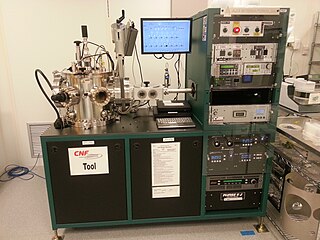
In physics, sputtering is a phenomenon in which microscopic particles of a solid material are ejected from its surface, after the material is itself bombarded by energetic particles of a plasma or gas. It occurs naturally in outer space, and can be an unwelcome source of wear in precision components. However, the fact that it can be made to act on extremely fine layers of material is utilised in science and industry—there, it is used to perform precise etching, carry out analytical techniques, and deposit thin film layers in the manufacture of optical coatings, semiconductor devices and nanotechnology products. It is a physical vapor deposition technique.
Isotope separation is the process of concentrating specific isotopes of a chemical element by removing other isotopes. The use of the nuclides produced is various. The largest variety is used in research. By tonnage, separating natural uranium into enriched uranium and depleted uranium is the largest application. In the following text, mainly the uranium enrichment is considered. This process is a crucial one in the manufacture of uranium fuel for nuclear power stations, and is also required for the creation of uranium based nuclear weapons. Plutonium-based weapons use plutonium produced in a nuclear reactor, which must be operated in such a way as to produce plutonium already of suitable isotopic mix or grade. While different chemical elements can be purified through chemical processes, isotopes of the same element have nearly identical chemical properties, which makes this type of separation impractical, except for separation of deuterium.
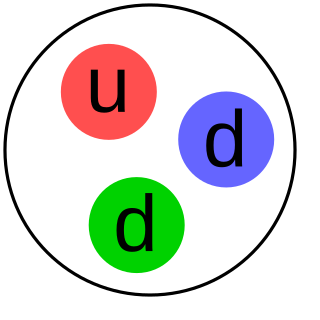
Neutron radiation is a form of ionizing radiation that presents as free neutrons. Typical phenomena are nuclear fission or nuclear fusion causing the release of free neutrons, which then react with nuclei of other atoms to form new isotopes—which, in turn, may trigger further neutron radiation. Free neutrons are unstable, decaying into a proton, an electron, plus an electron antineutrino with a mean lifetime of 887 seconds.
Irradiation is the process by which an object is exposed to radiation. The exposure can originate from various sources, including natural sources. Most frequently the term refers to ionizing radiation, and to a level of radiation that will serve a specific purpose, rather than radiation exposure to normal levels of background radiation. The term irradiation usually excludes the exposure to non-ionizing radiation, such as infrared, visible light, microwaves from cellular phones or electromagnetic waves emitted by radio and TV receivers and power supplies.
Elastic Recoil Detection Analysis (ERDA), also referred to as forward recoil scattering, is an Ion Beam Analysis technique in materials science to obtain elemental concentration depth profiles in thin films. This technique is known by several different names. These names are listed below. In the technique of ERDA, an energetic ion beam is directed at a sample to be characterized and there is an elastic nuclear interaction between the ions of beam and the atoms of the target sample. Such interactions are commonly of Coulomb nature. Depending on the kinetics of the ions, cross section area, and the loss of energy of the ions in the matter, Elastic Recoil Detection Analysis helps determine the quantification of the elemental analysis. It also provides information about the depth profile of the sample.
Chemical beam epitaxy (CBE) forms an important class of deposition techniques for semiconductor layer systems, especially III-V semiconductor systems. This form of epitaxial growth is performed in an ultrahigh vacuum system. The reactants are in the form of molecular beams of reactive gases, typically as the hydride or a metalorganic. The term CBE is often used interchangeably with metal-organic molecular beam epitaxy (MOMBE). The nomenclature does differentiate between the two processes, however. When used in the strictest sense, CBE refers to the technique in which both components are obtained from gaseous sources, while MOMBE refers to the technique in which the group III component is obtained from a gaseous source and the group V component from a solid source.

In nuclear and materials physics, stopping power is the retarding force acting on charged particles, typically alpha and beta particles, due to interaction with matter, resulting in loss of particle energy. Its application is important in areas such as radiation protection, ion implantation and nuclear medicine.
Radiation damage is the effect of ionizing radiation on physical objects. Radiobiology is the study of the action of ionizing radiation on living things, including the health effects of radiation in humans. High doses of ionizing radiation can cause damage to living tissue such as radiation burning and harmful mutations such as causing cells to become cancerous, and can lead to health problems such as radiation poisoning.
Rutherford backscattering spectrometry (RBS) is an analytical technique used in materials science. Sometimes referred to as high-energy ion scattering (HEIS) spectrometry, RBS is used to determine the structure and composition of materials by measuring the backscattering of a beam of high energy ions impinging on a sample.
Electron-beam processing or electron irradiation (EBI) is a process that involves using electrons, usually of high energy, to treat an object for a variety of purposes. This may take place under elevated temperatures and nitrogen atmosphere. Possible uses for electron irradiation include sterilization and cross-linking of polymers.
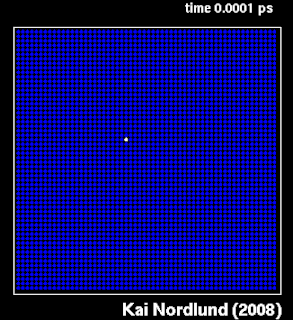
A collision cascade is a set of nearby adjacent energetic collisions of atoms induced by an energetic particle in a solid or liquid.
The threshold displacement energy is the minimum kinetic energy that an atom in a solid needs to be permanently displaced from its lattice site to a defect position. It is also known as "displacement threshold energy" or just "displacement energy". In a crystal, a separate threshold displacement energy exists for each crystallographic direction. Then one should distinguish between the minimum and average over all lattice directions threshold displacement energies. In amorphous solids it may be possible to define an effective displacement energy to describe some other average quantity of interest. Threshold displacement energies in typical solids are of the order of 10 - 50 eV.
Stopping and Range of Ions in Matter (SRIM) is a group of computer programs which calculate interaction of ions with matter; the core of SRIM is a program Transport of ions in matter (TRIM). SRIM is popular in the ion implantation research and technology community and also used widely in other branches of radiation material science.
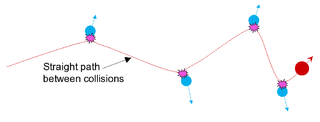
The binary collision approximation (BCA) signifies a method used in ion irradiation physics to enable efficient computer simulation of the penetration depth and defect production by energetic ions in solids. In the method, the ion is approximated to travel through a material by experiencing a sequence of independent binary collisions with sample atoms (nuclei). Between the collisions, the ion is assumed to travel in a straight path, experiencing electronic stopping power, but losing no energy in collisions with nuclei.
Radiation materials science describes the interaction of radiation with matter: a broad subject covering many forms of irradiation and of matter.
A Primary Knock-on Atom or PKA is an atom that is displaced from its lattice site by irradiation; it is, by definition, the first atom that an incident particle encounters in the target. After it is displaced from its initial lattice site, the PKA can induce the subsequent lattice site displacements of other atoms if it possesses sufficient energy, or come to rest in the lattice at an interstitial site if it does not.
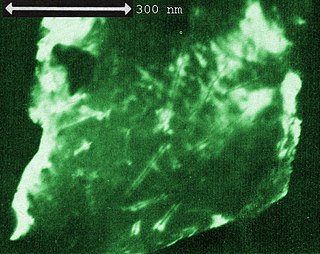
Ion tracks are damage-trails created by swift heavy ions penetrating through solids, which may be sufficiently-contiguous for chemical etching in a variety of crystalline, glassy, and/or polymeric solids. They are associated with cylindrical damage-regions several nanometers in diameter and can be studied by Rutherford backscattering spectrometry (RBS), transmission electron microscopy (TEM), small-angle neutron scattering (SANS), small-angle X-ray scattering (SAXS) or gas permeation.
Neutron embrittlement, sometimes more broadly radiation embrittlement, is the embrittlement of various materials due to the action of neutrons. This is primarily seen in nuclear reactors, where the release of high-energy neutrons causes the long-term degradation of the reactor materials. The embrittlement is caused by the microscopic movement of atoms that are hit by the neutrons; this same action also gives rise to neutron-induced swelling causing materials to grow in size, and the Wigner effect causing energy buildup in certain materials that can lead to sudden releases of energy.

Igor Serafimovich Tashlykov was a USSR and Belarusian physicist, Doctor of Physical and Mathematical Sciences (1989), Professor (1992), member of the New York Academy of Sciences (1994), and Belarusian Physical Society (1995). Places of work, positions: Research Institute of Applied Physical Problems (APP) of the Belarusian State University, Belarusian State Technological University, Maxim Tank Belarusian State Pedagogical University (BSPU).
References
- ↑ Ion-solid interactions, Cambridge Solid-State Science series, ch11, p295
- ↑ B. M. Paine and R. S. Averback, Ion beam mixing: basic experiments, Nucl. Instrum. Methods Phys. Res. B 7/8, 666 (1985)
- 1 2 3 4 Nastasi, Michael (17–29 July 2004). "Ion Beam Mixing" (PDF). Radiation Effects in Solids. Erice, Sicily, Italy: Los Alamos National Laboratory Materials Science and Technology Division. Retrieved 2 May 2007.
- ↑ K. Nordlund and M. Ghaly and R. S. Averback (1998). "Mechanisms of ion beam mixing in metals and semiconductors". J. Appl. Phys. 83 (3): 1238–1246. Bibcode:1998JAP....83.1238N. doi:10.1063/1.366821.
- ↑ Abedrabbo, S.; Arafah, D.E.; Gokce, O.; Wielunski, L.S.; et al. (May 2006). "Ion Beam Mixing for Processing of Nanostructure Materials". Journal of Electronic Materials . 35 (5): 834–839. doi:10.1007/BF02692536. S2CID 98541376 . Retrieved 2 May 2007.
- ↑ Abedrabbo, Sufian; Arafah, D.E.; Salem, S. (May 2005). "Ion Beam Mixing of Silicon-Germanium Thin Films". Journal of Electronic Materials . 34 (5): 468–473. doi:10.1007/s11664-005-0053-1. S2CID 95064618 . Retrieved 2 May 2007.